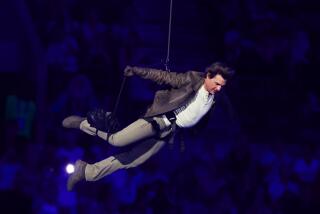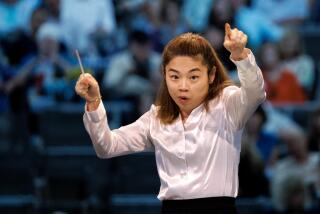Pacific Chorale In The USSR. A special report : For Singers, Last Show Is Acid Test : Tour: The group, which had been on the road for two weeks, knew its performance of Rachmaninoff would either move the audience or distance it.
LENINGRAD — Expect Murphy’s Law to be enforced rigorously, they said. Flexibility was referred to simply as “the F word.” This was the Soviet Union, after all, where schedules routinely can be bollixed, connections missed, tours forgotten, directions lost.
When you tempt fate here, fate wins. Usually.
But the Pacific Chorale arrived in this city of Peter the Great groggy from a long night train ride, in mostly croaky voice, craving a few hours’ sleep and a meal without cucumbers, and still managed to take on the Russian language, before a Russian audience, and win.
It was the final concert of a two-week chorale tour that had begun in Tallinn, Estonia, with participation in the international Bridges of Song Festival. The program in Leningrad, sung entirely a cappella, included five movements from Sergei Rachmaninoff’s “Vespers,” sung entirely in Russian.
The Rachmaninoff had become, by the concert date, a kind of acid test in the minds of the singers. The American portion of the program--with such selections as Randall Thompson’s “Alleluia,” Samuel Barber’s “Agnus Dei,” (a choral setting of his “Adagio for Strings”), Leonard Bernstein’s “Missa Brevis” and a short collection of American spirituals--would probably be satisfying, maybe even winning. But the Rachmaninoff would either move the audience, or keep it at arm’s length.
Especially daunting: The performance would mark the first time any American choir had performed the Rachmaninoff in Russian in the immense blue and white wedding cake that is the 18th-Century Smolny Cathedral.
The response was the first standing ovation ever accorded a performance in the three years that the cathedral has hosted concerts, according to the cathedral director.
In a land where life can be unsettlingly gray, and faces often are hard, the chorale had become happily accustomed to seeing those faces melt at each of its five concerts, both here and in Tallinn.
It is not for nothing that the northernmost Baltic state of Estonia is called the Wales of the East. Singing, to these people, is a profound exchange of both sentiment and ideas, and if the communication is clear, the gulf separating nations, ideologies and even languages vanishes, and a spiritual communion appears that is rare elsewhere.
During a Fourth of July concert, the chorale’s third in Tallinn, the musical partnership between the chorale and the Estonians found its most poignant level. The chorale teamed with the Estonian State Symphony Orchestra on Aaron Copland’s “Suite of Old American Songs” and Carl Orff’s breathless dervish of a piece, “Carmina Burana.”
Preparations began less than well. During two rehearsals at the studios of Estonian Radio, the orchestra clanked its way through the Orff with little inspiration--perhaps understandably: Like many other professionals in Estonia, orchestra members are paid little; most do not even own their instruments and instead play violins or trombones that they own collectively. Also, the orchestra has lost many of its players to more lucrative jobs in Finland, across the Baltic Sea. They are struggling, and are acutely aware of it.
However, there is such a thing as musical symbiosis. “Carmina Burana” is one of the Pacific Chorale’s favorites. No one would venture which ensemble pulled inspiration from the other, but by the end of the final “Carmina” rehearsal in the imposing Estonian Concert Hall, the piece had begun to crackle.
The concert drew a standing-room-only crowd.
“I think that’s the concert I’ll remember most,” said Hugh Davies, who coordinated the chorale’s tour. “It was such a combination of musical excellence and a spirit of friendship between the two countries. And there was such political significance in singing on our Independence Day to people from a country who want their own independence very badly. The crowning moment was when the chorale sang the Estonian national hymn, though.”
The singers had obtained a copy two days before of “Hoia, Jumal, Eestit,” a hymn that is not actually the Estonian national anthem, but is held in extraordinary reverence by audiences. At the end of the Fourth of July concert, the song brought the audience silently to its feet as the chorale sang it, in Estonian. After a long silence, the listeners began to clap in rhythm, and then to cheer. And then cry.
“Those are quite unprecedented audience responses in Estonia,” Davies said. “Estonian audiences simply do not stand and do not do the rhythmic clapping, and they certainly don’t cry.”
The orchestra, too, had been somewhat transformed. “To see how that orchestra was on that first day of rehearsal, with no money, no nothing, and to turn around so completely in three days,” said John Alexander, the chorale’s conductor. “I’ve never seen the faces of an orchestra so animated during a concert.” After the concert, Alexander was invited to return during the orchestra’s 1992-93 season to guest conduct.
Meanwhile, a segment of the Pacific Chorale was gaining attention elsewhere. Alexander’s Northridge Singers, a chamber choir from Cal State Northridge, where Alexander is head of choral music, sang in the competitive component of the festival, against choirs from Estonia, Norway, Russia and other European, Baltic and Soviet choirs, 30 altogether.
The day before the “Carmina Burana” concert, the Northridge was named best chamber choir of the festival.
Winning took away the disappointment of having missed a much-ballyhooed Americans-in-exile softball game, held the same day as the competition, on a local sports field below the medieval battlements of Tallinn’s Old Town.
Frisbees served as bases, and hits were declared ground rule doubles if they flew too near the woman practicing with her javelin.
Another familiar bit of Americana popped at the official opening of the Bridges of Song Festival, in a huge amphitheater near the waterfront. As massed amateur choirs from around the world filled the shell (the Pacific Chorale is a professional choir and did not participate), Jester Hairston took the podium to lead the hundreds of voices in the traditional American spiritual “Amen.” Hairston, who is 90 and lives in Los Angeles, has made a career of collecting, promoting and conducting spirituals and, with a little coaching, the massed choir--dressed in kimonos, lederhosen and jeans--finally caught onto this one.
An even more locally known American appeared on the podium briefly to give the opening blessing of the festival: the Rev. Robert Schuller, there at the invitation of American choral conductor John Williams, the festival’s principal organizer.
Through it all, the chorale learned to be flexible--musically, culturally, temperamentally, politically. When the tour was over, the singers could not only perform the Estonian national hymn but also strike a skillful bargain with a Leningrad cabbie, organize a midnight cruise on the Neva river (albeit with warm champagne), load a train in 10 minutes, breathe diesel fumes and still hold a pitch.
And they could recognize the power and universality of their art perhaps as never before.
More to Read
The biggest entertainment stories
Get our big stories about Hollywood, film, television, music, arts, culture and more right in your inbox as soon as they publish.
You may occasionally receive promotional content from the Los Angeles Times.










